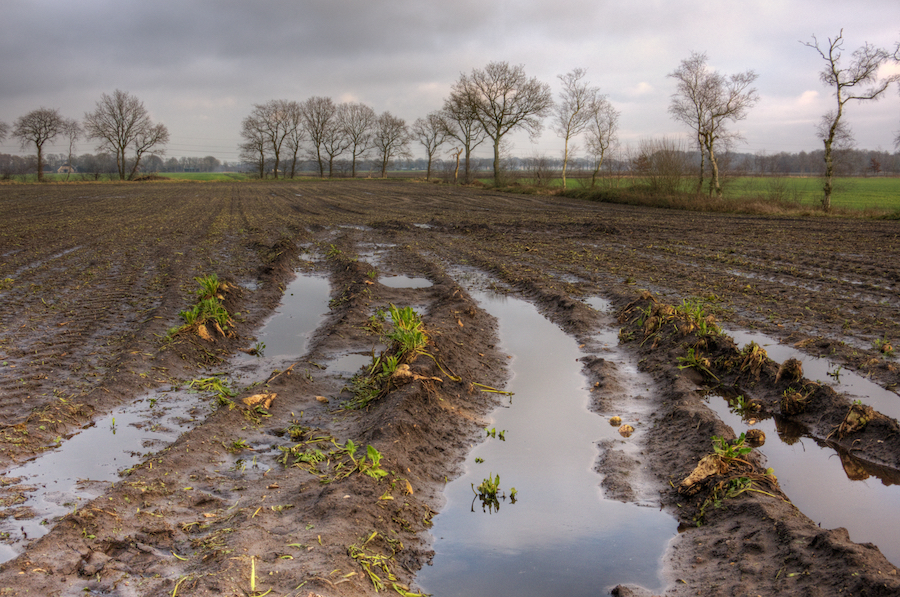Flooded fields and the impact on waterlogged sugar beet crops
17th November 2023
According to the BBRO’s latest bulletin in early November, poor harvesting conditions – with already wet soil continually being topped up by further rain – have led to slow and challenging harvest progress for many, with operators having to be selective in where they can travel and constantly having to change harvesting plans.

However, many crops have retained vigorous and healthy green canopies which will help dry out soils when the rain eventually stops, especially if temperatures remain mild. Despite a lack of recent sunshine, autumn growth has helped improve some already very good root yields.
Withstanding waterlogging
Sugar beet, like many crops has an ability to withstand waterlogging for a short period of time. The amount of time that the crop is underwater is key as this will affect the extent of anaerobic conditions the roots are exposed to. After this time there is an increased risk of ‘hypoxia’ in plants leading to cell death.
There is no precise critical period that roots remain unaffected as temperature, soil sediment levels and soil structure (soil aeration) will have an influence, but the crop should be able to tolerate 5–7 days underwater. After this, there is an increased risk of ‘hypoxia’ in plants leading to cell death.
When cells die secondary infection by bacteria and fungi is the main cause of losses, usually in the form of root rots. If roots begin to re-grow after being waterlogged, they may become mis-shaped and fangy. Sugar losses are also associated with plants being anaerobic as water logging triggers a range of enzyme and metabolic processes in the roots as they try to repair themselves.
The presence of healthy canopies on crops under water is not considered to have either a positive or negative effect. However, as water levels reduce and crops start growing again, having healthy tops may help crops recover quicker than those with poor canopies. Unfortunately, if a crop has been underwater for a long time both the roots and tops may also be killed with the tops turning black.
If crops have been under water for five days, consider digging some roots (about 20 from an affected and unaffected area) and letting them dry out in ambient conditions (not too warm) to see if there is any deterioration. Look for any softening, discoloration, or early signs of secondary infection, especially a vinegary smell after about 24-48 hours.
Any crops that have been under water and are considered suitable for processing should be harvested and delivered immediately to the factory. Harvest and clean as gently as possible as any excessive damage will increase the risk of root rots and further deterioration. Do not clamp waterlogged crops for any longer than necessary. Areas of fields which have been waterlogged will need managing separately to unaffected areas.
Foliar disease
With the onset of cooler autumn temperatures alongside the use of fungicides these factors will have helped reduce the severity of foliar disease. However, symptoms of rust and cercospora can be found in many crops. Fungicide trials are showing that fungicides have been very effective in slowing down disease progression in terms of canopy health. Analysis of different fungicides, and programmes on yield and sugar content are yet to be completed but a full report will be presented at the BBRO BeetTech conferences in February.
Differences in disease susceptibility between varieties are quite evident in many cases, especially where comparisons are available. Remember to consider this when making your variety selection for next season, especially for crops destined for later harvest dates.
Whilst cercospora has not reached epidemic proportions this season, symptoms are present in many crops. Interestingly, whilst the severity of symptoms has progressed on early infected plants resulting in occasional heavily infected plants in crops, conditions do not seem to have favoured widespread infection. There are some regional exceptions to this such as east and coastal Suffolk.
Sugar levels
Sugar levels have been stubbornly slow to improve but factory averages are slowly increasing. Factors such as an immature crop (remember how late some crops were drilled!) and low sunshine levels are underlying causes. Crop re-growth following drought on light land and then increased root hydration in wet soils have also conspired to reduce sugar levels. Crops with persistently low sugars are worthy of further investigation. Some high amino N in early delivered crops may be associated with poor sugar levels. This could be linked to high nitrogen levels in soils, especially where organic manures have been used. Too much nitrogen will depress sugar levels, so assessing your SNS is a key part of the decision process on how much inorganic N fertiliser to apply.
While running the harvester aggressively to remove soil in wet conditions may be necessary, make sure root damage levels are monitored. A badly damaged root will lose twice as much sugar as an undamaged root. Find an acceptable trade-off between cleaning and damage. Prioritise any crops with higher damage levels for immediate delivery.
Ensure a regular dialogue between harvester and haulier and avoid leaving large clamps for longer than necessary before delivery as these will warm up and accelerate sugar losses further. Monitor carefully for any root rots developing as this can also accelerate warming and sugar losses. Check cleaner loaders are working correctly and not causing further damage.
Join BBRO in February 2024 for the BeetTech events, where they will take a closer look at integrated pest management in sugar beet and provide the latest information from the BBRO trials, plus offer a peek at the work being undertaken by BBRO’s PhD students.
View the latest and historical BBRO advisory bulletins at https://bbro.co.uk/publications/advisory-bulletin/


